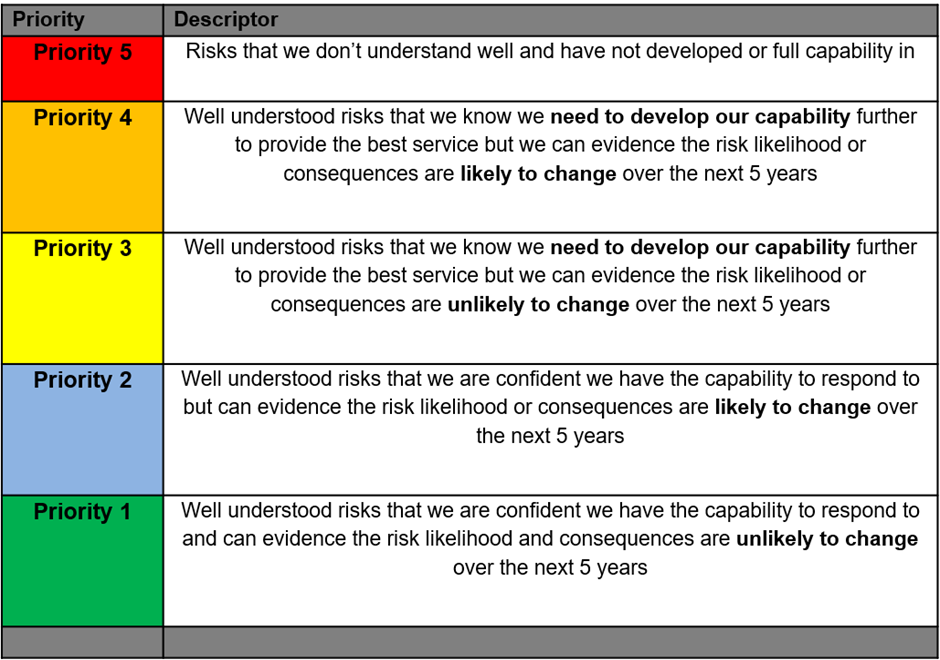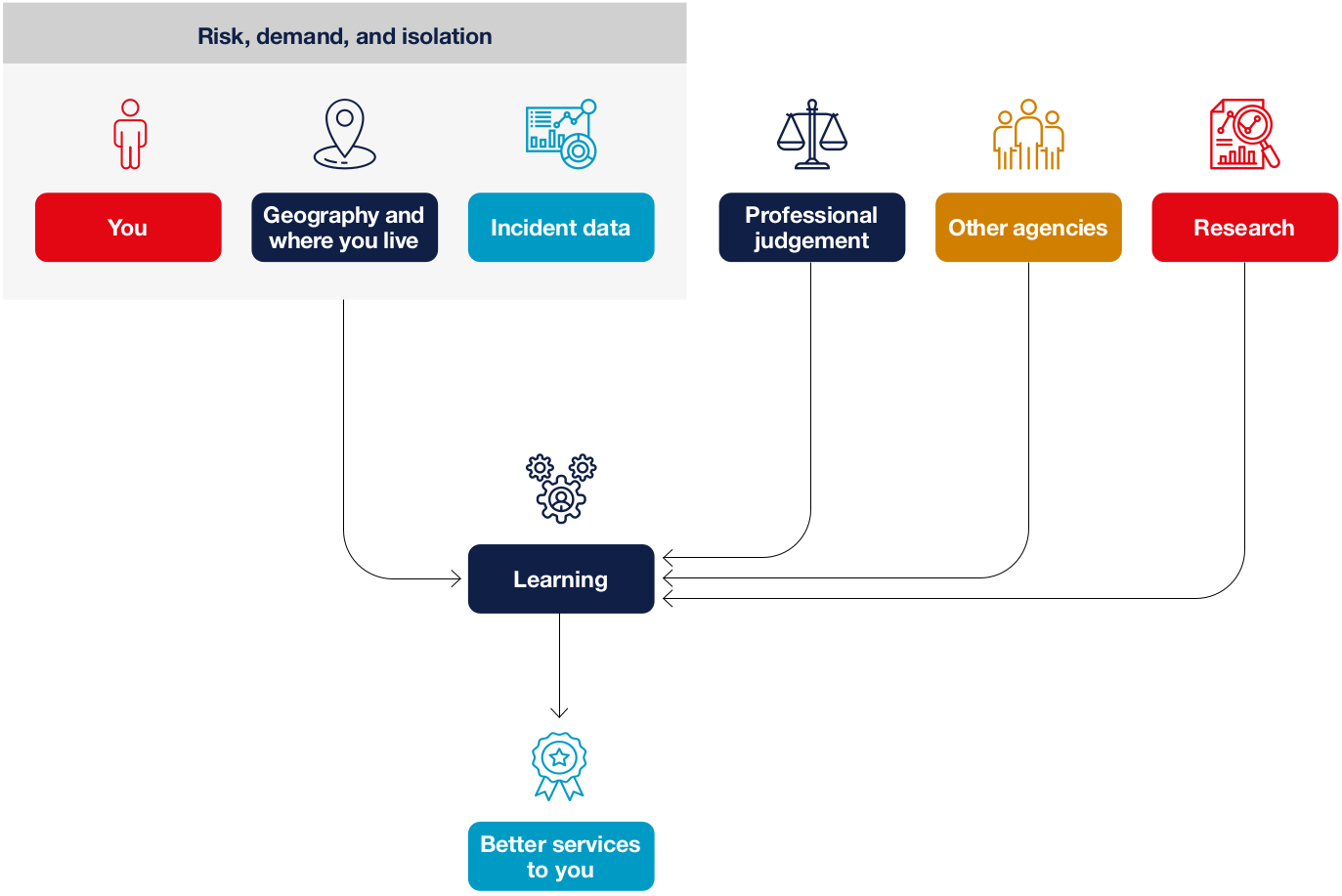How we assess the risks to you, our customers
We constantly gather feedback from you, from incidents, our colleagues, fire services across the world and other agencies. This means that we have a thorough understanding of our historic demand, local risk profiles, and how well we are performing. We also want to ensure that we look at how the nature of the risks we face may change and what new risks may present themselves. To do this we adopt a seven-stage process which involves:
Stage 1 - Risk identification
To ensure we have as complete and accurate a risk picture as possible, we draw data from several different sources:
1. National risks
The Government monitors the most significant emergencies that the UK could face over the next five years through its National Risk Assessment. The National Risk Register (NRR) is the public version of this assessment. It provides advice on how people, businesses and the emergency services can better prepare for emergencies.
2. Kent and Medway area risks
Kent Local Resilience Forum
This forum brings different types of organisations together to actively work to prepare for, respond to and recover from any major emergency in Kent and Medway. Visit the Kent Prepared website for more information.
The Community Risk Register (CRR) sets out the risks facing our communities and how they are being dealt with and include, for example flooding, animal disease, adverse weather and pandemic flu.
Census and other data
We use census data to analyse changes in the makeup of our communities. We have also used the Kent Analytics population data used by Kent County Council (KCC) to plan services. By combining this with information from studies such as those by the National Fire Chiefs Council, we can see where and for who we need to target our activities. (The equality of access documents provides a range of information about different groups of people and ideas, and the actions which services could take to make a positive difference and ensure everyone can and does access our services.)
Growth and infrastructure frameworks
Produced by local authorities these frameworks detail what building and development is likely to take place in the medium to long term. They help us to identify possible future changes in the location of demand and the nature of the risks that we respond to.
Other studies
We also draw on other theme-specific studies – for example, KCC’s evaluation of the risks and impacts of climate change on Kent and Medway and their strategy Framing Kent’s future 2022-26.
3. Continuous learning
We learn from many other sources including:
- National Operational Learning
- Joint Operational Learning
- Institution of Fire Engineers
- In house debriefing and incident assurance
- Professional debates and conferencing
4. Historic incident data
We collect data about every incident we attend. This is fed into a national database. We use this to identify what incidents we most frequently attend, which have the greatest impact on our customers, and where they most frequently occur. This allows us to align our resources and services to where the demand and risk is most likely to happen and also to spot patterns and trends indicating how these factors may change in the future.
Stage 2 - Risk analysis
In this stage we cross-map the various risk data sources and produce a list of risks that we believe apply to fire and rescue service activities – either directly or indirectly.
In this Community Risk Management Plan (CRMP) we have identified 52 risks which we have assessed our services against. This broad range of risks are not limited to what have traditionally been fire and rescue activities and also consider how we may use the capabilities we have to deliver better outcomes for customers in new areas of risk.
Stage 3 - Risk exclusion
The next step is to list all the risks we have excluded from our analysis. These are risks that are featured in places such as the National Risk Register, but which we feel neither directly or indirectly affect our activities, for example a port blockade. If you think we have missed any risks, you wll be able to tell us as part of this consultation.
Stage 4 - Risk assessment
We use accepted risk assessment methods to scrutinise the list of risks that we have identified. Using historic incident data, national trends and studies, we assess the likelihood of a risk being realised, comparative to another. This likelihood is assessed in relation to Kent and Medway, rather than nationally.
We then assess the impact, should the risk occur. While this is a subjective process, we use the following assessment criteria to improve consistency when looking at the impact on:
- the welfare of our customers
- firefighters and other emergency responders
- the environment
- local, regional, and national economies
- essential community services
To make these impact assessment decisions, we use local data from previous incidents and case studies from other incidents nationally and, where appropriate, internationally. We also consider their impact against our current plans and capabilities, which helps to give a reflection of our current risk profile.
We then plot the outcome of our risk assessment on a ‘5 x 5 risk matrix’ – a graph representing likelihood and consequence scores – enabling us to view risk outcomes relative to one another.
Stage 5 - Risk prioritisation
Some risks will always be classified as high risk – for example pandemic flu. However, this does not necessarily mean that we class them as a higher priority over other risks. It may be that the likelihood of a high risk occurring is difficult for us to reduce, or our current plans and capabilities to respond to the risk are current and robust.
We therefore give our risk assessment score a priority rating from one to five. This is based on our assessment of:
- our current capabilities and whether they need to be improved
- our ability to influence the likelihood of the risk occurring
- how we see the risk evolving over time
To obtain the final list of risk priorities, we multiply the scores for likelihood, impact and priority.

From this list, we identify themes in the high priority risks and turn them into strategic challenges. These are the areas where we think we can develop our capabilities to have a positive impact.
Stage 6 - Engagement and consultation
Any changes we make to our services are driven by our risk assessment. Because we provide services for our customers, we want to make sure any changes are done with your consent.
It is therefore important that we engage with you as customers, community groups, colleagues, partner agencies and other stakeholders, when building our risk assessment. Accessibility and inclusion lie at the heart of this approach, providing us with the widest possible audience, a greater understanding of the risks, and ensures any proposed changes take your requirements into account.
Following our engagement, we take the results of what people have said and adapt our risk assessments accordingly.
Finally, we present the final version to our Fire Authority for sign off on behalf of the public.
Stage 7 - Control measures
Having a detailed and accurate picture of the risks enables us to put in place plans, or control measures, to improve our services and risk outcomes. In doing so, we identify what change we are trying to deliver and what benefits the change will provide. We take an integrated approach to managing the risk, with our departments working in partnership to achieve our strategic intentions.

